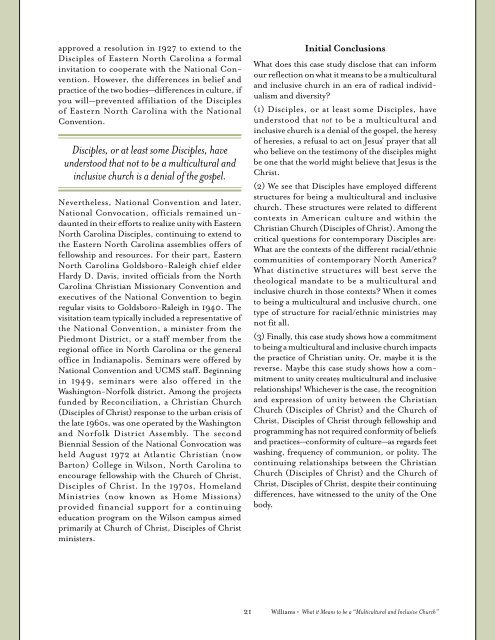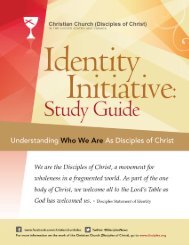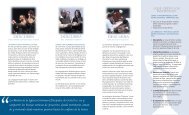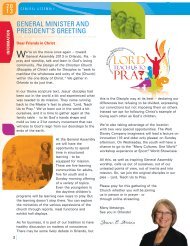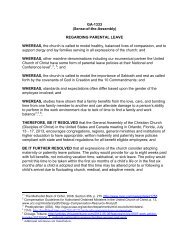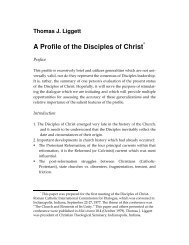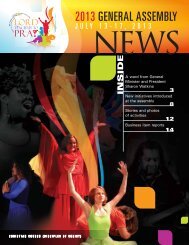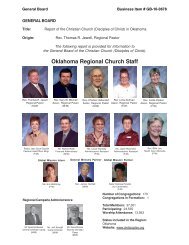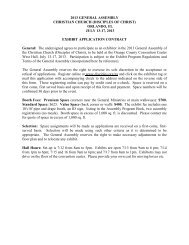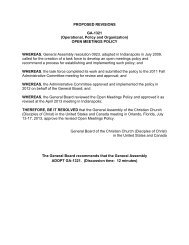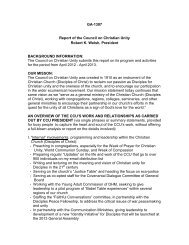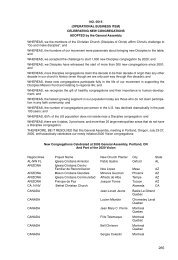RESOURCING THE CHURCH FOR ECUMENICAL MINISTRy A ...
RESOURCING THE CHURCH FOR ECUMENICAL MINISTRy A ...
RESOURCING THE CHURCH FOR ECUMENICAL MINISTRy A ...
Create successful ePaper yourself
Turn your PDF publications into a flip-book with our unique Google optimized e-Paper software.
approved a resolution in 1927 to extend to the<br />
Disciples of Eastern North Carolina a formal<br />
invitation to cooperate with the National Convention.<br />
However, the differences in belief and<br />
practice of the two bodies—differences in culture, if<br />
you will—prevented affiliation of the Disciples<br />
of Eastern North Carolina with the National<br />
Convention.<br />
Disciples, or at least some Disciples, have<br />
understood that not to be a multicultural and<br />
inclusive church is a denial of the gospel.<br />
Nevertheless, National Convention and later,<br />
National Convocation, officials remained undaunted<br />
in their efforts to realize unity with Eastern<br />
North Carolina Disciples, continuing to extend to<br />
the Eastern North Carolina assemblies offers of<br />
fellowship and resources. For their part, Eastern<br />
North Carolina Goldsboro-Raleigh chief elder<br />
Hardy D. Davis, invited officials from the North<br />
Carolina Christian Missionary Convention and<br />
executives of the National Convention to begin<br />
regular visits to Goldsboro-Raleigh in 1940. The<br />
visitation team typically included a representative of<br />
the National Convention, a minister from the<br />
Piedmont District, or a staff member from the<br />
regional office in North Carolina or the general<br />
office in Indianapolis. Seminars were offered by<br />
National Convention and UCMS staff. Beginning<br />
in 1949, seminars were also offered in the<br />
Washington-Norfolk district. Among the projects<br />
funded by Reconciliation, a Christian Church<br />
(Disciples of Christ) response to the urban crisis of<br />
the late 1960s, was one operated by the Washington<br />
and Norfolk District Assembly. The second<br />
Biennial Session of the National Convocation was<br />
held August 1972 at Atlantic Christian (now<br />
Barton) College in Wilson, North Carolina to<br />
encourage fellowship with the Church of Christ,<br />
Disciples of Christ. In the 1970s, Homeland<br />
Ministries (now known as Home Missions)<br />
provided financial support for a continuing<br />
education program on the Wilson campus aimed<br />
primarily at Church of Christ, Disciples of Christ<br />
ministers.<br />
21<br />
Initial Conclusions<br />
What does this case study disclose that can inform<br />
our reflection on what it means to be a multicultural<br />
and inclusive church in an era of radical individualism<br />
and diversity?<br />
(1) Disciples, or at least some Disciples, have<br />
understood that not to be a multicultural and<br />
inclusive church is a denial of the gospel, the heresy<br />
of heresies, a refusal to act on Jesus’ prayer that all<br />
who believe on the testimony of the disciples might<br />
be one that the world might believe that Jesus is the<br />
Christ.<br />
(2) We see that Disciples have employed different<br />
structures for being a multicultural and inclusive<br />
church. These structures were related to different<br />
contexts in American culture and within the<br />
Christian Church (Disciples of Christ). Among the<br />
critical questions for contemporary Disciples are:<br />
What are the contexts of the different racial/ethnic<br />
communities of contemporary North America?<br />
What distinctive structures will best serve the<br />
theological mandate to be a multicultural and<br />
inclusive church in those contexts? When it comes<br />
to being a multicultural and inclusive church, one<br />
type of structure for racial/ethnic ministries may<br />
not fit all.<br />
(3) Finally, this case study shows how a commitment<br />
to being a multicultural and inclusive church impacts<br />
the practice of Christian unity. Or, maybe it is the<br />
reverse. Maybe this case study shows how a commitment<br />
to unity creates multicultural and inclusive<br />
relationships! Whichever is the case, the recognition<br />
and expression of unity between the Christian<br />
Church (Disciples of Christ) and the Church of<br />
Christ, Disciples of Christ through fellowship and<br />
programming has not required conformity of beliefs<br />
and practices—conformity of culture—as regards feet<br />
washing, frequency of communion, or polity. The<br />
continuing relationships between the Christian<br />
Church (Disciples of Christ) and the Church of<br />
Christ, Disciples of Christ, despite their continuing<br />
differences, have witnessed to the unity of the One<br />
body.<br />
Williams • What it Means to be a “Multicultural and Inclusive Church”


